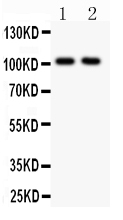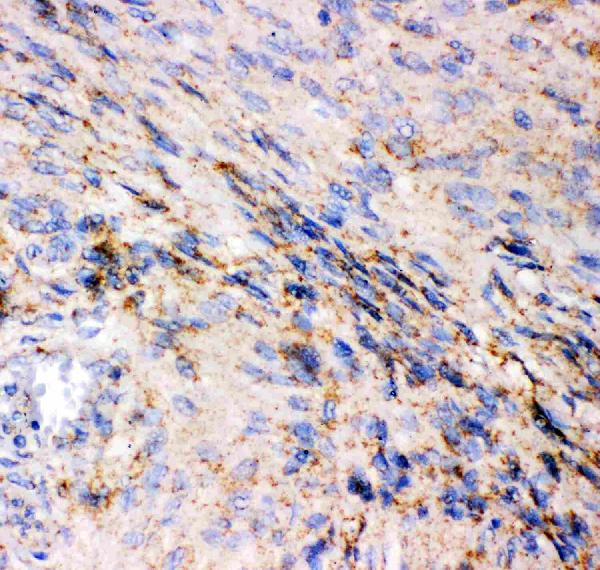Product Info Summary
| SKU: | PB9204 |
|---|---|
| Size: | 100 μg/vial |
| Reactive Species: | Human, Mouse, Rat |
| Host: | Rabbit |
| Application: | IHC, WB |
Customers Who Bought This Also Bought
Product info
Product Name
Anti-Glutamate Receptor 1/GRIA1 Antibody Picoband®
SKU/Catalog Number
PB9204
Size
100 μg/vial
Form
Lyophilized
Description
Boster Bio Anti-Glutamate Receptor 1/GRIA1 Antibody Picoband® catalog # PB9204. Tested in IHC, WB applications. This antibody reacts with Human, Mouse, Rat. The brand Picoband indicates this is a premium antibody that guarantees superior quality, high affinity, and strong signals with minimal background in Western blot applications. Only our best-performing antibodies are designated as Picoband, ensuring unmatched performance.
Storage & Handling
Store at -20˚C for one year from date of receipt. After reconstitution, at 4˚C for one month. It can also be aliquotted and stored frozen at -20˚C for six months. Avoid repeated freeze-thaw cycles.
Cite This Product
Anti-Glutamate Receptor 1/GRIA1 Antibody Picoband® (Boster Biological Technology, Pleasanton CA, USA, Catalog # PB9204)
Host
Rabbit
Contents
Each vial contains 4mg Trehalose, 0.9mg NaCl, 0.2mg Na2HPO4, 0.05mg NaN3.
Clonality
Polyclonal
Isotype
Rabbit IgG
Immunogen
E.coli-derived human GRIA1 recombinant protein (Position: A19-R360). Human GRIA1 shares 98% amino acid (aa) sequence identity with both mouse and rat GRIA1.
*Blocking peptide can be purchased. Costs vary based on immunogen length. Contact us for pricing.
Cross-reactivity
No cross-reactivity with other proteins
Reactive Species
PB9204 is reactive to GRIA1 in Human, Mouse, Rat
Reconstitution
Add 0.2ml of distilled water will yield a concentration of 500ug/ml.
Observed Molecular Weight
101 kDa
Calculated molecular weight
101506 MW
Background of GluR1
GLUR1, Glutamate receptor 1, is a protein that in humans is encoded by the GLUR1 gene. GLUR1 mRNA is widely expressed in human brain. Glutamate receptors are the predominant excitatory neurotransmitter receptors in the mammalian brain and are activated in a variety of normal neurophysiologic processes. The classification of glutamate receptors is based on their activation by different pharmacologic agonists. The GRIA1 belongs to a family of alpha-amino-3-hydroxy-5-methyl-4-isoxazole propionate (AMPA) receptors. Each of the members (GRIA1-4) include flip and flop isoforms generated by alternative RNA splicing. The receptor subunits encoded by each isoform vary in their signal transduction properties. The isoform presented here is the flop isoform. In situ hybridization experiments showed that human GRIA1 mRNA is present in granule and pyramidal cells in the hippocampal formation.
Antibody Validation
Boster validates all antibodies on WB, IHC, ICC, Immunofluorescence, and ELISA with known positive control and negative samples to ensure specificity and high affinity, including thorough antibody incubations.
Application & Images
Applications
PB9204 is guaranteed for IHC, WB Boster Guarantee
Assay Dilutions Recommendation
The recommendations below provide a starting point for assay optimization. The actual working concentration varies and should be decided by the user.
Immunohistochemistry (Paraffin-embedded Section), 0.5-1μg/ml, Human, Mouse, Rat, By Heat
Western blot, 0.1-0.5μg/ml, Human, Mouse, Rat
Positive Control
WB: Rat Brain Tissue, Mouse Brain Tissue
IHC: Mouse Brain tissue, Rat Brain tissue, Human Meningeoma tissue
Validation Images & Assay Conditions

Click image to see more details
Figure 1. Western blot analysis of GRIA1 using anti-GRIA1 antibody (PB9204).
Electrophoresis was performed on a 5-20% SDS-PAGE gel at 70V (Stacking gel) / 90V (Resolving gel) for 2-3 hours.
lane 1: Recombinant Human GRIA1 Protein 0.5ng.
After Electrophoresis, proteins were transferred to a Nitrocellulose membrane at 150mA for 50-90 minutes. Blocked the membrane with 5% Non-fat Milk/ TBS for 1.5 hour at RT. The membrane was incubated with rabbit anti-GRIA1 antigen affinity purified polyclonal antibody (Catalog # PB9204) at 0.5 μg/mL overnight at 4°C, then washed with TBS-0.1%Tween 3 times with 5 minutes each and probed with a goat anti-rabbit IgG-HRP secondary antibody at a dilution of 1:10000 for 1.5 hour at RT. The signal is developed using an Enhanced Chemiluminescent detection (ECL) kit (Catalog # EK1002) with Tanon 5200 system. A specific band was detected for GRIA1 at approximately 40KD. The expected band size for GRIA1 is at 40KD.

Click image to see more details
Figure 2. Western blot analysis of GRIA1 using anti-GRIA1 antibody (PB9204).
Electrophoresis was performed on a 5-20% SDS-PAGE gel at 70V (Stacking gel) / 90V (Resolving gel) for 2-3 hours. The sample well of each lane was loaded with 50ug of sample under reducing conditions.
Lane 1: Rat Brain Tissue Lysate,
Lane 2: Mouse Brain Tissue Lysate.
After Electrophoresis, proteins were transferred to a Nitrocellulose membrane at 150mA for 50-90 minutes. Blocked the membrane with 5% Non-fat Milk/ TBS for 1.5 hour at RT. The membrane was incubated with rabbit anti-GRIA1 antigen affinity purified polyclonal antibody (Catalog # PB9204) at 0.5 μg/mL overnight at 4°C, then washed with TBS-0.1%Tween 3 times with 5 minutes each and probed with a goat anti-rabbit IgG-HRP secondary antibody at a dilution of 1:10000 for 1.5 hour at RT. The signal is developed using an Enhanced Chemiluminescent detection (ECL) kit (Catalog # EK1002) with Tanon 5200 system. A specific band was detected for GRIA1 at approximately 101KD. The expected band size for GRIA1 is at 101KD.

Click image to see more details
Figure 3. IHC analysis of GRIA1 using anti-GRIA1 antibody (PB9204).
GRIA1 was detected in paraffin-embedded section of Mouse Brain Tissue. Heat mediated antigen retrieval was performed in citrate buffer (pH6, epitope retrieval solution) for 20 mins. The tissue section was blocked with 10% goat serum. The tissue section was then incubated with 1μg/ml rabbit anti-GRIA1 Antibody (PB9204) overnight at 4°C. Biotinylated goat anti-rabbit IgG was used as secondary antibody and incubated for 30 minutes at 37°C. The tissue section was developed using Strepavidin-Biotin-Complex (SABC)(Catalog # SA1022) with DAB as the chromogen.

Click image to see more details
Figure 4. IHC analysis of GRIA1 using anti-GRIA1 antibody (PB9204).
GRIA1 was detected in paraffin-embedded section of Rat Brain Tissue. Heat mediated antigen retrieval was performed in citrate buffer (pH6, epitope retrieval solution) for 20 mins. The tissue section was blocked with 10% goat serum. The tissue section was then incubated with 1μg/ml rabbit anti-GRIA1 Antibody (PB9204) overnight at 4°C. Biotinylated goat anti-rabbit IgG was used as secondary antibody and incubated for 30 minutes at 37°C. The tissue section was developed using Strepavidin-Biotin-Complex (SABC)(Catalog # SA1022) with DAB as the chromogen.

Click image to see more details
Figure 5. IHC analysis of GRIA1 using anti-GRIA1 antibody (PB9204).
GRIA1 was detected in paraffin-embedded section of Human Meningeoma Tissue. Heat mediated antigen retrieval was performed in citrate buffer (pH6, epitope retrieval solution) for 20 mins. The tissue section was blocked with 10% goat serum. The tissue section was then incubated with 1μg/ml rabbit anti-GRIA1 Antibody (PB9204) overnight at 4°C. Biotinylated goat anti-rabbit IgG was used as secondary antibody and incubated for 30 minutes at 37°C. The tissue section was developed using Strepavidin-Biotin-Complex (SABC)(Catalog # SA1022) with DAB as the chromogen.
Protein Target Info & Infographic
Gene/Protein Information For GRIA1 (Source: Uniprot.org, NCBI)
Gene Name
GRIA1
Full Name
Glutamate receptor 1
Weight
101506 MW
Superfamily
glutamate-gated ion channel (TC 1.A.10.1) family
Alternative Names
Glutamate receptor 1;GluR-1;AMPA-selective glutamate receptor 1;GluR-A;GluR-K1;Glutamate receptor ionotropic, AMPA 1;GluA1;GRIA1;GLUH1, GLUR1; GRIA1 GLUH1, GLUR1, GLURA, GluA1, HBGR1 glutamate ionotropic receptor AMPA type subunit 1 glutamate receptor 1|AMPA 1|AMPA-selective glutamate receptor 1|gluR-1|gluR-A|gluR-K1|glutamate receptor, ionotropic, AMPA 1
*If product is indicated to react with multiple species, protein info is based on the gene entry specified above in "Species".For more info on GRIA1, check out the GRIA1 Infographic

We have 30,000+ of these available, one for each gene! Check them out.
In this infographic, you will see the following information for GRIA1: database IDs, superfamily, protein function, synonyms, molecular weight, chromosomal locations, tissues of expression, subcellular locations, post-translational modifications, and related diseases, research areas & pathways. If you want to see more information included, or would like to contribute to it and be acknowledged, please contact [email protected].
Specific Publications For Anti-Glutamate Receptor 1/GRIA1 Antibody Picoband® (PB9204)
Hello CJ!
PB9204 has been cited in 3 publications:
*The publications in this section are manually curated by our staff scientists. They may differ from Bioz's machine gathered results. Both are accurate. If you find a publication citing this product but is missing from this list, please let us know we will issue you a thank-you coupon.
Loss of the golgin GM130 causes Golgi disruption, Purkinje neuron loss, and ataxia in mice
Disruption of glutamate neurotransmitter transmission is modulated by SNAP-25 in benzo[a]pyrene-induced neurotoxic effects
Loss of the golgin GM130 causes Golgi disruption, Purkinje neuron loss, and ataxia in mice
Recommended Resources
Here are featured tools and databases that you might find useful.
- Boster's Pathways Library
- Protein Databases
- Bioscience Research Protocol Resources
- Data Processing & Analysis Software
- Photo Editing Software
- Scientific Literature Resources
- Research Paper Management Tools
- Molecular Biology Software
- Primer Design Tools
- Bioinformatics Tools
- Phylogenetic Tree Analysis
Customer Reviews
Have you used Anti-Glutamate Receptor 1/GRIA1 Antibody Picoband®?
Submit a review and receive an Amazon gift card.
- $30 for a review with an image
0 Reviews For Anti-Glutamate Receptor 1/GRIA1 Antibody Picoband®
Customer Q&As
Have a question?
Find answers in Q&As, reviews.
Can't find your answer?
Submit your question
1 Customer Q&As for Anti-Glutamate Receptor 1/GRIA1 Antibody Picoband®
Question
We are currently using anti-Glutamate Receptor 1/GRIA1 antibody PB9204 for human tissue, and we are well pleased with the WB results. The species of reactivity given in the datasheet says human, mouse, rat. Is it possible that the antibody can work on horse tissues as well?
Verified Customer
Verified customer
Asked: 2019-12-12
Answer
The anti-Glutamate Receptor 1/GRIA1 antibody (PB9204) has not been validated for cross reactivity specifically with horse tissues, though there is a good chance of cross reactivity. We have an innovator award program that if you test this antibody and show it works in horse you can get your next antibody for free. Please contact me if I can help you with anything.
Boster Scientific Support
Answered: 2019-12-12




